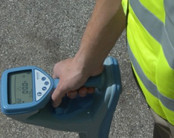When you’re planning a construction project of any kind, it pays to know what’s underground before you start digging. While many utilities and features will show up on maps and land overviews, some things may not be marked. If your site is old, it may pre-date mapping, or you might find unexpected materials when you dig. While this may not be a problem in many situations, you could risk injury to human and equipment alike. This is where ground penetrating radar, or GPR, comes in! GPR is used in a variety of industries to give a view of what you’ll be getting into before you dig.
Locating Utilities
Even when you know approximately where a utility is, it can help to have a more specific location. In some cases, you will be able to use magnetic field sensors to find hidden utilities. In other situations, you may need to use GPR to locate them, particularly if they do not have an electrical current or if there is external noise.
The Limits of GPR
While GPR is an excellent solution in many situations, it does have its limits. Because GPR signals are absorbed into the soil, some soil contents, like clay and aline, can cause the depth of scan to be reasonably low. Additionally, while GPR does give you an idea of where things are underground, it may not provide a full picture. If you have a swath of land with a lot of large rocks, for instance, detecting the difference between utility lines and boulders may be difficult.
Mapping
When you are working with a large area and have little previous information about the setup, GPR can be used to create a full computer-generated map. To do this, you must use a highly controlled scanning method, but the end result will give you a complete and honest look at everything that is underground in your site. Not only can this help identify utilities, but it can help find other objects as well.
GPR Services from Concrete Visions
Concrete Visions has over 12 years of experience and expertise in concrete scanning and we know how to detect any problems lurking beneath the surface. We use ground penetrating radar accurately and expertly and are familiar with many other methods that can be used when appropriate like concrete x-ray and electromagnetic conductivity. We are also very familiar with the latest construction safety techniques and train all of our workers to do their work quickly, accurately, and safely. If you would like to learn more about how we can help you, give us a call at (410) 766-2210 or visit us online. For more articles and tips, follow us on Facebook, Twitter, LinkedIn, and Google+.

